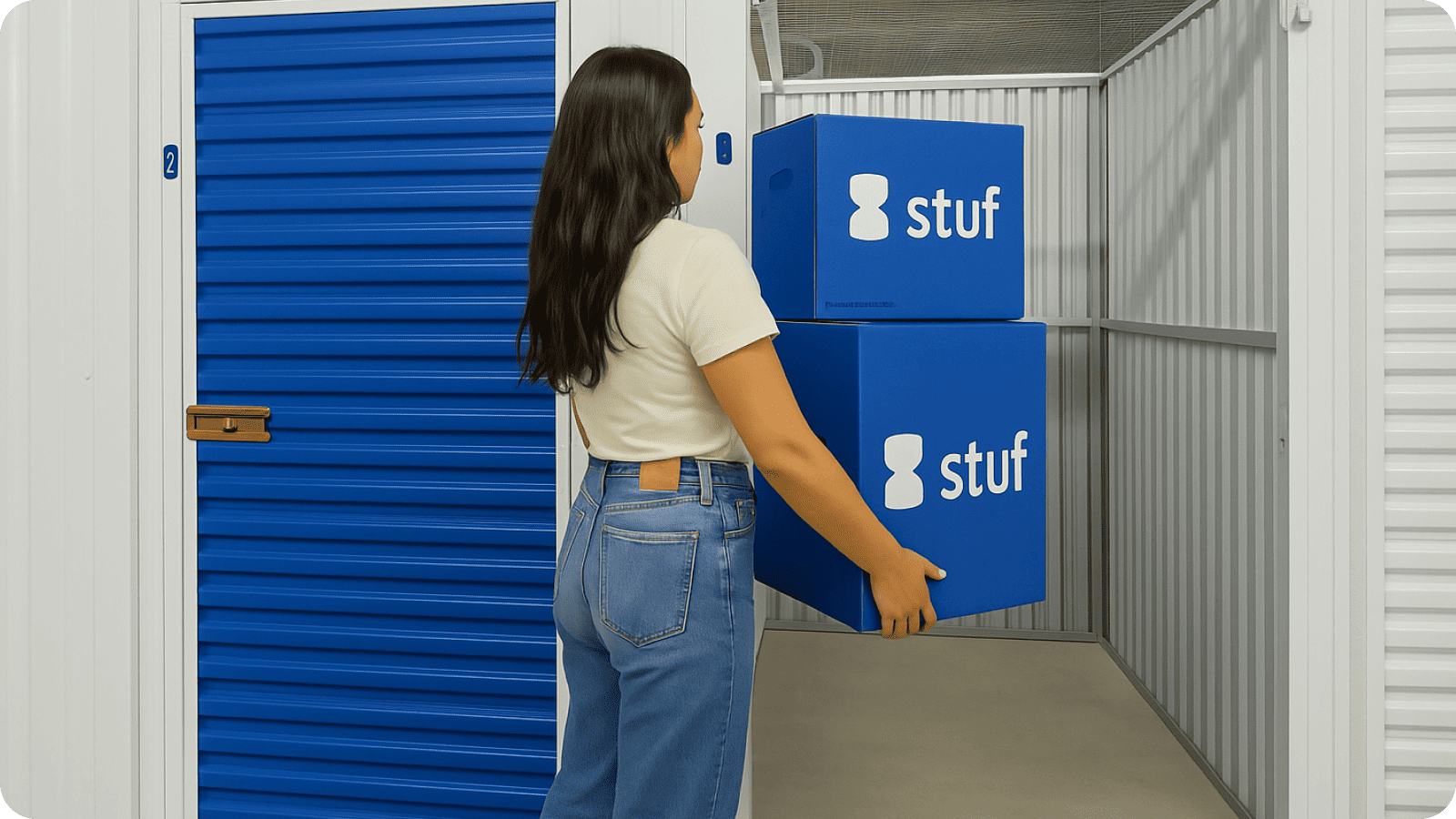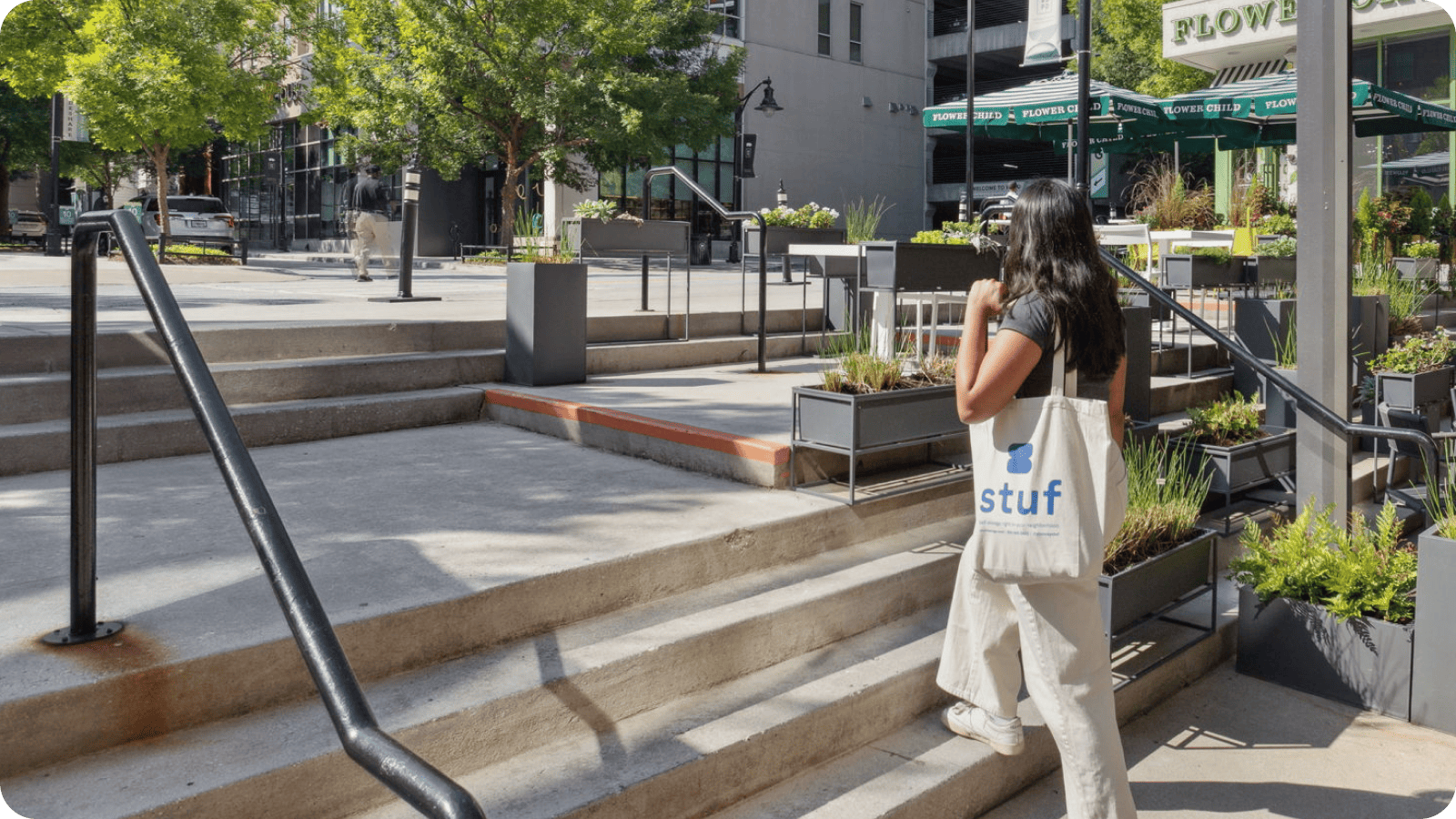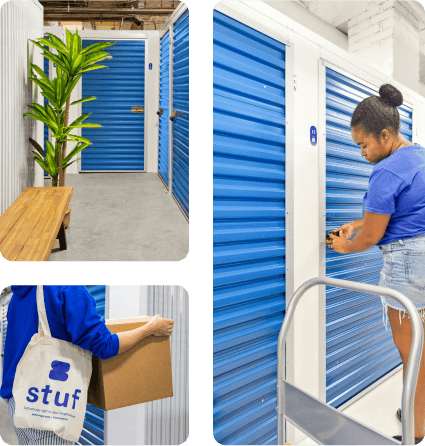You’ve just finished packing boxes, the moving truck is on its way, and then it hits you. Your new place isn’t quite ready. Or maybe you’re downsizing, and suddenly there’s nowhere to put the dining set you can’t part with. For countless people, moments like these are when self-storage becomes the quiet hero that eases their worries and keeps life moving smoothly.
For first-time renters, though, renting storage space isn’t always straightforward. How big of a unit will actually fit your belongings? Is climate control worth the extra cost? And what about security or hidden fees that could catch you off guard?
In this self-storage guide, we’ll bring clarity to those questions. So, by the time you rent a storage unit, you’ll not only have the extra space you need but also the peace of mind that your belongings are safe, secure, and accessible.
What is Self-Storage?
At its core, self-storage means renting storage space outside your home or office for items that can’t stay in your current space. Units can be as small as a locker or as large as a room, and you can choose short-term or long-term rental depending on your situation.
The primary benefit you gain from this setup is control. You hold the key, decide when to access your things, and can rely on security measures like gated entry, cameras, and individual locks for peace of mind.
This idea of storing belongings dates back to the ancient Chinese and Egyptians. The modern version with individual rentable units only emerged in the United States in the late 19th century. But it wasn’t until the 1960s that the version many of us recognize today, with garage-style doors, took off in Texas. Back then, many homes didn’t have basements, so extra space became a necessity.
Fast forward to today, and the industry has exploded. More than 70,000 facilities are now operating worldwide, with over 50,000 in the U.S. alone. The demand also continues to grow as more people move into cities, downsize, or seek flexible ways to manage their belongings.
The most common types of self-storage you’ll come across include:
- Indoor Units – Located inside a building, offering added protection from weather
- Drive-Up Units – Garage-style spaces you can pull right up to for quick loading and unloading.
- Climate-Controlled Units – Temperature and humidity regulated, perfect for electronics, documents, or wooden furniture.
- Vehicle Storage – Spaces designed for cars, boats, RVs, or motorcycles.
Why Do You Need a Storage Unit?
The reasons people rent a storage unit are as varied as life itself. Sometimes it’s about convenience, sometimes it’s about protection, and often it’s a mix of both.
Here are the most common situations where self-storage makes a meaningful difference:
-
Moving or Relocation
Moves rarely happen as neatly as we’d like. A storage unit creates breathing room by holding your belongings safely until your new home is ready, reducing the stress of juggling multiple timelines.Not sure how to fit self-storage in your moving itinerary? Check out our guide on how to use self-storage to make your move easier.
- Home Renovation or Construction
Renovations are exciting, but they also turn your living space upside down. Additionally, dust, debris, and constant activity put furniture and valuables at risk. Renting storage space during this time can keep your belongings protected and out of the way, so contractors can work more efficiently. - Downsizing
Moving into a smaller home often means difficult decisions about what to keep. Instead of rushing to part with treasured possessions, a storage unit offers time and flexibility. You can hold onto sentimental or seasonal items until you’re ready to decide what truly fits your new lifestyle. - Decluttering and Organizing
Many people want a calmer, more organized living space, but letting go of items isn’t always easy. Self-storage provides a middle ground. You can clear out what doesn’t fit at home while keeping it accessible if you need it later. - Lifestyle and Temporary Needs
Frequent travelers, military personnel, and individuals in temporary living situations rely on self-storage to safeguard belongings during absences. It offers stability and reassurance, knowing personal items are secure even when life feels unsettled - Estate Management and Life Transitions
Major life changes, such as divorce, inheritance, or the loss of a loved one, can leave families with more belongings than they can manage at once. Renting storage space provide a respectful, manageable option, giving people time to process and make decisions without urgency or added stress. -
Business Storage
For small businesses, storage units act as cost-effective extensions of the workplace, holding inventory, equipment, files, or seasonal stock. This not only frees up valuable square footage but also helps keep operations more organized and efficient.Learn what features to look for to get the right storage unit for your business
-
Security and Protection
Facilities often include gated access, surveillance, and individual locks, features that bring peace of mind when storing valuables, sensitive documents, or items that would otherwise feel vulnerable at home or in the office.
What to Consider Before

A. Choosing the right size
Renting storage space is a bit like choosing an apartment. Too small and you’ll feel cramped, too big and you’ll pay for space you don’t really use. Fortunately, storage facilities typically offer units ranging from locker-sized spaces to large garage-style rooms, so the key is matching the size to your needs.
Here’s how to think about it:
- Start with your inventory
Write down (or snap photos of) everything you plan to store. Remember, boxes stack neatly, but sofas, wardrobes, and appliances quickly eat up space. A rough tally will immediately give you a sense of whether you’re needs are closer to “a closet” or “a small garage.” -
Think about how you’ll use the unit
- Short-term storage (e.g., between moves): You can usually get away with packing things tightly
- Long-term storage: It’s worth sizing up slightly so you can create aisles or leave space to access boxes without emptying the whole unit.
- Frequent access: If you’ll be in and out grabbing items, extra space for maneuvering makes a huge difference.
-
Account for the “future you”
If you expect to add more belongings later, such as seasonal décor, new furniture, or business stock, it may be cheaper in the long run to size up from the beginning rather than switch units later.Pro tip: When in doubt, size up slightly when renting storage space. It’s easier to organize, protects items from damage, and gives you breathing room when life inevitably adds “just one more box.”
For a complete guide on what fits in different unit sizes, check out our comprehensive sizing guide.

B. Location
When renting storage space, location can quietly determine how satisfied you’ll be. If you plan to visit often, it’s worth choosing a facility close to home or work. For long-term or occasional use, you can save money by going a little farther out of town.
Apart from the facility’s address, where your unit sits inside the property also matters. Drive-up units make moving heavy furniture easy, while indoor or upper-level spaces often come with added climate control and security.
Think about how often you’ll visit, what you’ll be carrying, and whether you value convenience over cost to determine which placement will suit you best.
%20(1)%20(1).png?width=287&height=162&name=image%20(3)%20(1)%20(1).png)
C. Self-storage cost
The cost of renting storage space can vary widely, depending on factors like:
- Location – Units in busy cities or high-demand areas often cost more than double compared to rural towns.
- Unit size – Larger spaces naturally come with higher monthly rates.
- Seasonal demand – Prices typically rise during peak moving seasons (like summer) and dip in slower months.
- Amenities and services – Features such as climate control, 24/7 access, or moving assistance increase costs.
- Security – Facilities with gated entry, on-site staff, and video surveillance usually charge premium prices.
- Accessibility – Ground-floor or drive-up units are more convenient but can also be more expensive.
- Lease terms – Longer commitments may offer discounts, while flexible month-to-month rentals often cost slightly more.
To put this into perspective, a standard 10x10 unit averages around $200 - $400 in Los Angeles, about $100 - $200 in Houston, and anywhere from $50–$150 in rural states like Iowa.
When it comes to lease length, a 10x10 unit on a month-to-month lease might run $130–$150 per month, while committing to six months or longer could lower the cost to $105–$120 monthly, saving renters 10–20% over time.
Learn more about what you can expect to pay when renting a self-storage unit with our full guide on self-storage costs this 2025.
Remember, however, that there are plenty of discounts you can take advantage of to reduce costs. Some companies like us at Stuf Storage offer seasonal discounts and first-time renter discounts where you can save up to 50% on self-storage costs for the first three months.

D. Unit type
Think of storage units the way you’d think of housing. Some are like garages, easy to drive right up to, while others feel more like apartments inside a secure building. The type you choose will shape how convenient and protective your storage experience feels.
Outdoor Units
These are the classic garage-style spaces where you can pull your car or truck right up to the door. They’re perfect for heavy furniture, appliances, or anything bulky that you don’t want to carry through hallways or elevators.
Outdoor units are often more affordable and convenient if you’ll be loading and unloading frequently. The trade-off is that they usually lack climate control, so items are more exposed to seasonal temperature swings and humidity.
Indoor Units
Indoor facilities house units within a building, which means added protection from the elements and, in many cases, enhanced security. They may require using hallways or elevators, which adds a step to moving in, but they offer a cleaner, more controlled environment.
- Climate-controlled units: These units regulate temperature and sometimes humidity, making them ideal for sensitive belongings such as wooden furniture, electronics, artwork, or documents. If you live in an area with extreme heat, cold, or humidity, climate-controlled storage is often worth the higher price tag to prevent damage
Not sure what kind of self-storage unit you need? Check out our guide about climate-controlled vs non-climate-controlled units.

E. Lease length
One of the biggest advantages self-storage has over other kinds of storage solutions is that users are rarely locked into a long contract. Most facilities offer month-to-month leases, giving you the freedom to store belongings for as long or as short as you need without major commitment.
Some facilities do set minimum terms, often around three months. Shorter weekly rentals are less common, but can sometimes be found.
If you know you’ll need storage for a longer stretch, it may be worth asking about discounts for six-month or annual leases. These often reduce the monthly cost by 10–20%.
Whatever lease you choose, it’s important to read the agreement carefully. It will outline your rental period, payment schedule, and the process for ending the lease.
Additionally, keep in mind that timely payments are crucial. Late fees can add up quickly, and in extreme cases, unpaid units may even be subject to auction under local laws..

F. Security features and amenities
When renting storage space, the security features a facility offers are often what gives peace of mind. Good security usually means a combination of physical protection and monitoring. This includes perimeter fencing, gated entry (often with electronic keypads or card-access), strong lighting in hallways and outdoor areas, and video surveillance cameras covering all entry points, hallways, and unit exteriors.
Beyond security, certain amenities or facility features can make a big difference in how well your stuff stays protected. For example, amenities like 24/7 access, moving carts, drive-up unit access, or onsite supplies (boxes, packing materials) don’t necessarily increase security, but they significantly improve convenience and reduce friction.
Even strong individual locks (disc or cylinder locks) or reinforced unit doors are important, since your lock is your first line of defense.
Putting in the extra effort to pick a facility with solid security and useful amenities will cost a bit more sometimes, but often ends up saving you both worry and cost.
If you’re planning to use your self-storage as an extension of your business inventory, check out our guide on what features to look for and why they matter.

G. Self-storage insurance
Even in the most secure facility, unexpected things happen, including storms, theft, accidental fire, or damage beyond your control. In these situations, self-storage insurance can prove helpful.
Many storage facilities require or strongly encourage renters to carry insurance to protect against these perils. At Stuf, we offer an additional insurance option for $9/ month, which can protect up to $5000 worth of your belongings.
Pro tip: When reviewing insurance options, pay attention to what’s excluded. Floods, earthquakes, mold, gradual water damage, and pest damage are often omitted from standard policies. Also, check any sub-limits on high-value items (art, jewelry, collectibles) and whether your policy requires a deductible.
Step-by-Step Guide for Renting Storage Space
Step 1: Take inventory and set priorities
List the items you plan to store and decide which are most important. This helps you choose the right unit size and avoid paying for unused space.
Step 2: Set budget and rental duration
Determine how much you’re willing to spend and for how long you want to keep your items in storage. When renting storage space, factor in not only the monthly rate but also hidden fees like admin charges or lock purchases.
Step 3: Research and tour facilities
Look beyond glossy websites and visit facilities in person if possible. There, don’t be shy to ask personals about security features, access hours, and overall cleanliness before committing.
Step 4: Compare options and total costs
Weigh the location, amenities, and lease flexibility against the price. Additionally, add up all potential costs to get a realistic picture, not just the advertised rate.
Step 5: Review and sign rental agreement
Read the fine print. Check for red flags like steep late fees, unclear insurance requirements, or automatic renewal clauses. And make sure security and insurance align with your needs.
Step 6: Move in and organize for easy access
Use sturdy boxes, label everything, and place frequently used items near the front. Smart organization saves stress and time later.
Step 7: Maintain and plan an exit strategy
Check in on your unit periodically to ensure everything’s secure. When it’s time to move out, give notice as required in your lease to avoid extra charges.
FAQs for Renting a Storage Unit
What storage unit size do I need for my belongings?
This depends on how much you’re storing. A 5x5 unit is like a small closet, great for boxes and seasonal items. A 10x10 unit fits the contents of a one-bedroom apartment. If you’re unsure, most facilities have staff who can help, and many offers online size calculators.
What items are prohibited from being stored in a storage unit?
Hazardous materials, flammable liquids, explosives, perishable food, and illegal items are universally banned. Each facility may also have its own restrictions, so always double-check your rental agreement.
How secure are storage units and what security measures are in place?
Most modern facilities use gated access, CCTV surveillance, and individual locks. Some, like us at Stuf Storage, even offer advanced features like smart-entry systems
Can I insure the items I store? Is insurance required?
Yes. Many facilities require proof of insurance before renting storage space.
What do I need to bring or provide to rent a storage unit?
Typically, you’ll need a government-issued ID, a payment method (credit card or bank details), and proof of insurance if required. Some places may also require an initial deposit.
Can I change the size of my storage unit after renting it?
At Stuf, we allow you to transfer to a different unit as the need arises as long as there are available units
What happens if I miss a rent payment?
Late fees usually apply after the due date. If payments are missed for an extended period, facilities can deny access to your unit and, eventually, auction off items as permitted by law.
Can I share a storage unit with someone else?
Yes, but only the person listed on the lease is legally responsible for the unit. If you plan to share, make sure all parties are clear on access, payments, and responsibilities.
Ready to Rent a Storage Unit with Confidence?
The first time you rent a storage unit, the key is to think beyond just square footage. Ask yourself: Will this unit make my life easier? Will it protect the things I care about?
Choosing well means finding a space that balances size, cost, security, and accessibility, so you’re not paying for what you don’t need, and you’re not compromising on peace of mind.
Once you’ve moved in, treat the unit like an extension of your home or office. Keep it organized, label clearly, and place frequently used items up front. This way, your storage works for you, not against you.
At Stuf Storage, we make that possible with secure, modern facilities designed for first-time renters and seasoned users alike.
Take the stress out of storage. Find a Stuf Storage location near you today!






